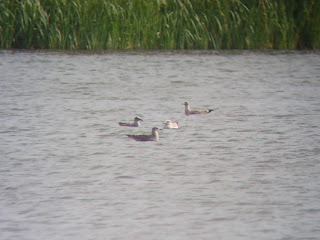22nd July 2018
A while back Chris Packham announced that he would be doing a series of
bioblitzes around the UK. Looking at the detail I was a little bit sceptical - Chris is a very knowledgeable and passionate naturalist, but it seemed to be trying to cram in too much. The marketing information suggested creating a benchmark for each reserve, but with five reserves a day that's not a great amount of data. The tagline 'reserves are not enough', whilst in itself very true, also seemed rather odd considering most of the sites being visited were nature reserves. Scanning down the list the only Norfolk venue was Weeting Heath and was listed as invite-only, so I didn't give it any more thought.
A few weeks later I was invited to help out. It turned out that although Chris and his team would only be present at each site for a few hours, the idea was that local naturalists did the actual recording and then there would be interviews and footage of some of the more interesting finds. I was asked to help record fungi, although as it happened the weather was so dry there wasn't any, so I just recorded as many miscellaneous species as possible.
The warden at Weeting, James, was an excellent host, and briefed the assembled group about the plan for the day, and also left cake and tea making facilities in his dormitory. I opted to stay near the visitors centre whilst the moth trap was emptied in the hope of seeing some Breckland specialties. As it was I didn't see any new macro moths (I was hoping for Tawny Wave or a late Cream-spot Tiger, but Oblique-striped and Mere Wainscot were the main Breckland species). I did however see quite a few new micros as several were retained for checking, and Oak Eggar is always nice to see.
Heading across the road it didn't take long for me to realise that I hadn't brought enough drink, as the heat was scorching. I began by checking the flowerheads, mostly Ragwort and Yarrow, and soon saw a Brassy Longhorn moth (Nemophora metallica) and several Forester moths.
I was also able to take advantage of the numerous experts present to identify some of the things I didn't recognise. Pip Collyer and Helen Smith were looking at an attractive spider, Neoscona adianta, whilst Nick Owens identified a solitary wasp I'd caught as Oxybelus uniglumis. Steve Lane helped with the beetles, with Gastrophysa polygoni, Galeruca tanaceti and Silpha laevigata all seen.



Returning to the visitors centre I caught up with Joe Harkness and Andy Musgrove & family. After re-hydrating I had a quick look around, seeing the Broad-leaved Helleborines and noting the leaf mines of Bucculatrix frangutella on Buckthorn. Chris Packham arrived at around 17:45, and after introducing himself and getting distracted by a dog, he gave a passionate address about the need to act now to protect and enhance our wildlife, which will culminate in a walk for wildlife in London (click here for more details). He also said that some of the sites visited had never had a bioblitz or wide-scale recording before, so for some sites at least they do indeed now have a benchmark for the future. All in all despite the heat it was an enjoyable day, and many thanks go to James and the NWT staff for their organisation.
























































